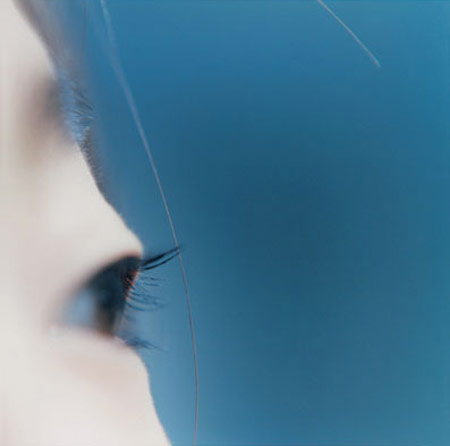A Large Aperture (e.g..f/2) will result in one thing being in focus and the rest of the image will be blurred. This is known as a Minimum Depth of Field (for information on Maximum Depth of Field click here). This image above is by August Sander (Young Farmers, Westerwald 1914) shows the three figures clearly but the background is a blurred haze due to the use of a Minimum Depth of Field.
In this black & white image by Linda McCartney 'Through a Glass Teapot' 1996 the tree is projected upside down in the water of a glass teapot (like a lens or a camera obscura). She has focussed our eye by using a shallow depth of field to blur the back ground and keep us focussed on the projected tree. Her use of burnt edges frames the image beutifully.
Penn is an interesting photographer who combined commercial success with his own artistic projects. His portfolio includes high class fashion photography, intimate portraits of key figures and beautiful close up shots of cigarette butts and old containers. Penn was able to mix glamourous high fashion photographs with more thoughtful personal work.
Rinko Kawauchi is a contemporary Japanese photographer who creates beautiful and elegant images that find the beauty in the everyday. Kawauchi uses a Minimum Depth of Field (for example f/2 – a large hole) which results in only a fraction of the image being in focus – these images have a shallow depth.
Kawauchi explores the poetry of the common place – a dead wasp on a window sill, a brief glance of the eye and a piece of chicken hanging over a table. These are none events – the kind of thing we may notice briefly and possibly dismiss or contemplate in a day dream.
The everyday has been a fascination for many artists – the things they immediately experience as part of their existence. Jean-Baptiste-Simeon Chardin worked in the 18th Century. His images were often simple and focussed on the remains of a meal left on a table. This humble scene became poignant in Chardin’s hands.
With this series the Starn’s were interested in Moths who are the ugly cousin to the beautiful, colourful, flower loving butterflies. Moths in comparison are monochrome, dull and are mainly seen at night attracted to light – and if it is a candle it can lead to their own death. The Starn Twins believe this makes moths more like humans – imperfect and craving things that will lead to our demise. To reflect the fragile quality of a moth they print the image on thin photographic paper that seems like it will crumble if touched like a moth’s wing. Their use of reproducing the same image again and again comments on Photography’s ability to be endlessly reproduced.
Further reading -
"The Work of Art in the Age of Mechanical Reproduction" by Walter Benjamin
an example of 'tilt-shift' Kris Kros photography
At first glance these images seen like toy models. In this image above the horses seem plastic where in reality they are actual horses. They have been created using a tilt shift lens - this involves tilting the camera lens to distort the plane of focus and shifting the lens to distort the perspective. Today, most photographers simply take a digital photograph and apply the tilt-shift distortions via software. Ronaldo Fonseca uses the traditional method to create tilt-shift images with no digital manipulation.
Ronaldo Fonseca
These images do what art does best - reflect the real world back to us and allows us to see it in a new light. The eye is drawn to the focused center of the image and creates the illusion of scenes from a dream. Here is a fascinating video using time-lapse and the tilt and shift effect - 'The Sand Pit' by Sam O'Hare. It creates a moving surreal dream.
Thomas Allen has taken an old pulp fiction book and cut into the front cover - creating a three dimensional image. These mini sculptures are then rephotographed from a particular angle for added drama. In this above image one man punches another who then falls backwards. It has all the drama of a pulp novel or film noir. Allen has used a minimum depth of field to blur out the punching man and draw our eyes to the falling man. Are these works book art, sculpture or photography?
'Thomas Allen, in essence, is a still life artist who through a very creative process disrupts the stillness. By carefully selecting from primarily vintage paperback novels and science journals, he brings two-dimensional images forward into three dimensional space. With simple lightning and the use of simple tools (i.e., scissors and razor-sharp knives), figures are cut out, bent and juxtapose in ways that present the tension and dynamics of staged drama. Other techniques are applied in achieving a pure sense of humor that also defy the original use of these materials and their ultimate destiny of being read once and retiring for eternity on the nearest bookshelf.'

















